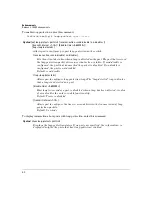
68
Enhancements
Release L.10.28 Enhancements
By default, all ports on a switch are untrusted. If a VLAN interface is untrusted:
■
The switch intercepts all ARP requests and responses on the port.
■
Each intercepted packet is checked to see if its IP-to-MAC binding is valid. If a binding is invalid,
the switch drops the packet.
You must configure trusted ports carefully. For example, in the topology in Figure 2, Switch B may
not see the leased IP address that Host 1 receives from the DHCP server. If the port on Switch B that
is connected to Switch A is untrusted and if Switch B has dynamic ARP protection enabled, it will
see ARP packets from Host 1 as invalid, resulting in a loss of connectivity.
On the other hand, if Switch A does not support dynamic ARP protection and you configure the port
on Switch B connected to Switch A as trusted, Switch B opens itself to possible ARP poisoning from
hosts attached to Switch A.
Figure 2. Configuring Trusted Ports for Dynamic ARP Protection
Take into account the following configuration guidelines when you use dynamic ARP protection in
your network:
■
You should configure ports connected to other switches in the network as trusted ports. In this
way, all network switches can exchange ARP packets and update their ARP caches with valid
information.
■
Switches that do not support dynamic ARP protection should be separated by a router in their
own Layer 2 domain. Because ARP packets do not cross Layer 2 domains, the unprotected
switches cannot unknowingly accept ARP packets from an attacker and forward them to
protected switches through trusted ports.
















































